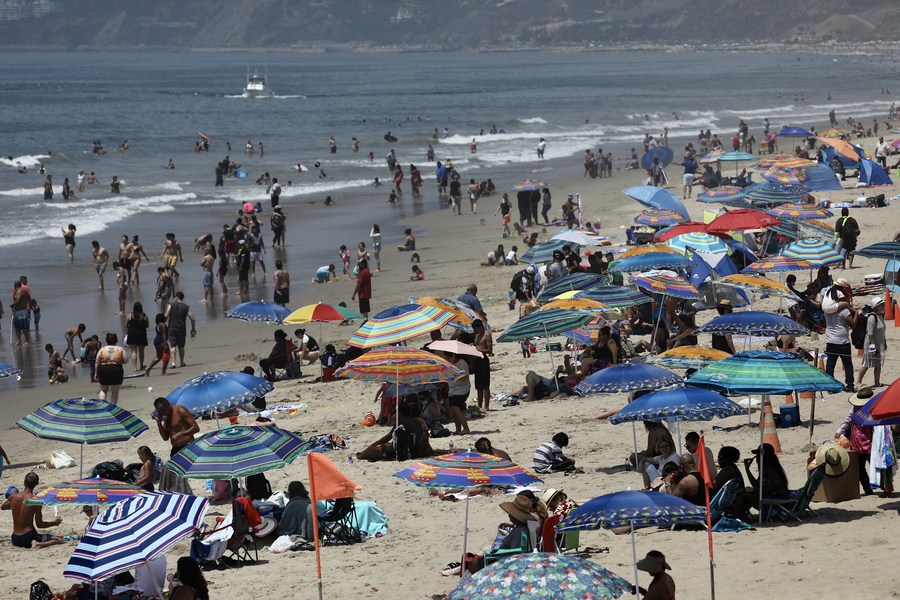
Cyclists wearing face masks ride along the Santa Monica Beach, Los Angeles County, the United States, Aug. 15, 2020. (Xinhua)
"The heat wave is consistent with what scientists say to expect from climate change," says J. Marshall Shepherd.
DENVER, the United States, Aug. 15 (Xinhua) -- One month ago, the United States' Death Valley recorded a 128 degrees Fahrenheit (53.3 degrees Celsius) temperature, the hottest on the planet since 2017 and one degree behind the hottest ever recorded on Earth.
Most scientists agreed the worst was yet to come in 2020. They were right.
"This weekend could feature the hottest weather in three years for several cities in the western United States as fears the heat will lead to increased wildfire danger and coronavirus spread," USA Today reported on Saturday.
Dangerously hot conditions will occur during the afternoon and early evening hours each day, the National Weather Service (NWS) added.
"More than 80 million people are under excessive heat alerts this weekend with record temperatures possible in over 10 states," CNN reported.
COMPOUNDED PROBLEMS
With the U.S. battle against COVID-19 entering its sixth month, the scorching heat wave has added more misery to those sweltering each day, and frustrated fire fighters grappling with wildfires exploding throughout the region.
The extremely hot and arid weather has activated forest fuels, meteorologists said, and Mother Nature responded -- a record wildfire season is also underway.
Firefighters continue to fight wildfires raging throughout the West, as temperatures rise in the Southwest, Great Basin and California, the National Interagency Fire Center posted on Saturday.
"Officials in California, Oregon and Colorado are battling a series of wildfires that have collectively torched about 100,000 acres -- and things could get worse this weekend with intense heat set to descend on much of the U.S.," CNN reported Saturday, as the weekend began.
The furnace blast hit the western states of California, Arizona, Utah, Nevada, Texas, Oklahoma, and Colorado, but also evaporated normally moist Louisiana and Arkansas, CNN added.
The heat event is especially dangerous because of higher than normal humidity due to tropical moisture streaming into the region from Hurricane Elida, CNBC meteorologists said.
"Usually, California heat waves mean a dry heat, which is a saving grace. But what's unusual here are the remnants of Hurricane Elida, which are adding significantly more moisture into the atmosphere and will make California much muggier," Daniel Swain, a climate scientist at the University of California, Los Angeles, told NBC.
"The extra humidity makes a big difference in a bad way, from a public health perspective," Swain added.

People are seen on the Santa Monica Beach, Los Angeles County, the United States, Aug. 15, 2020. (Xinhua)
HOT CONTINUATION
On July 5, CBS News reported that "270 million people, or 84 percent of America's population" would be impacted by a continuing summer blast that would "bake most of the United States."
"If you thought July was hot, you were right: it was one of Earth's hottest moments ever recorded," USA Today confirmed.
According to a report released on Thursday by the National Oceanic and Atmospheric Administration (NOAA) "July 2020 tied with July 2016, as the second hottest month ever recorded on Earth."
The report coincides with overwhelming data to support its conclusion.
"More than 34 million people are under excessive heat watches and warnings across California and the Southwest," NBC reported this weekend. "Most of the heat alerts go into effect on Friday and will stay in effect through early next week. During this time, dozens of record highs could be set in the coming days for cities like Las Vegas, Phoenix, Tucson and Salt Lake City."
In the most populous state of the United States, "an intense multi-day heatwave kicked into high gear Friday, triggering power outages throughout California as the state's power grid became overwhelmed by energy demands," CNBC said.
The "Stage 3 emergency alert" declared on Saturday evening by the California Independent System Operator was the first statewide emergency of this kind since 2001.
"More than 300,000 customers in both Northern and Southern California were without power at points Friday evening," CNBC reported.
More than 80 million people were under heat alerts on Friday from the Central and Southern Plains to nearly the entire West Coast, the NWS noted.
"Dallas, Houston, Phoenix, Las Vegas, Los Angeles, Portland and Seattle are among the cities under heat alert," the NWS said.
CLIMATE CHANGE
The Trump administration has repeatedly ridiculed and admonished scientific data proving global warming, and many of Trump's followers adhere to this far-fetched idea.
In fact, Trump's energy policy focuses on burning fossil fuels, such as oil and gas, that have been scientifically proven to deplete the protective ozone atmospheric layer around the Earth, scientists say.
July 2020 also marked the 44th consecutive July and the 427th consecutive month with temperatures above the 20th-century average, according to the NOAA.
"The heat wave is consistent with what scientists say to expect from climate change," said J. Marshall Shepherd, a meteorologist at the University of Georgia and a former president of the American Meteorological Society.
Shepherd told The New York Times last month that "of the weather phenomena affected by climate change, heat waves show the strongest signal of the warming planet."
He compared the process to fertilizing a lawn. Grass will grow naturally, but "when we put fertilizer in the soil, it grows differently," Shepherd said.
"And so 'the natural cycle of heat waves is fertilized by anthropogenic climate change,'" he added. ■



